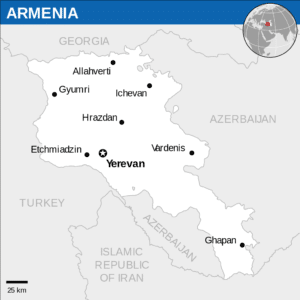The name has traditionally been derived from Hayk (Հայկ), the legendary patriarch of the Armenians and a great-great-grandson of Noah, who, according to the 5th-century AD author Moses of Chorene, defeated the Babylonian king Bel in 2492 BC and established his nation in the Ararat region. The further origin of the name is uncertain. It is also further postulated that the name Hay comes from one of the two confederated, Hittite vassal states—the Ḫayaša-Azzi (1600–1200 BC).

The exonym Armenia is attested in the Old Persian Behistun Inscription (515 BC) as Armina. The Ancient Greek terms Ἀρμενία (Armenía) and Ἀρμένιοι (Arménioi, “Armenians”) are first mentioned by Hecataeus of Miletus (c. 550 BC – c. 476 BC). Xenophon, a Greek general serving in some of the Persian expeditions, describes many aspects of Armenian village life and hospitality in around 401 BC. He relates that the people spoke a language that to his ear sounded like the language of the Persians. According to the histories of both Moses of Chorene and Michael Chamchian, Armenia derives from the name of Aram, a lineal descendant of Hayk. The Table of Nations lists Aram as the son of Shem, to whom the Book of Jubilees attests,
“And for Aram there came forth the fourth portion, all the land of Mesopotamia between the Tigris and the Euphrates to the north of the Chaldees to the border of the mountains of Asshur and the land of ‘Arara.”
Jubilees 8:21 also apportions the Mountains of Ararat to Shem, which Jubilees 9:5 expounds to be apportioned to Aram. The historian Flavius Josephus also states in his Antiquities of the Jews,
“Aram had the Aramites, which the Greeks called Syrians;… Of the four sons of Aram, Uz founded Trachonitis and Damascus: this country lies between Palestine and Celesyria. Ul founded Armenia; and Gather the Bactrians; and Mesa the Mesaneans; it is now called Charax Spasini.”
History:
Antiquity:
Armenia lies in the highlands surrounding the mountains of Ararat. There is evidence of an early civilisation in Armenia in the Bronze Age and earlier, dating to about 4000 BC. Archaeological surveys in 2010 and 2011 at the Areni-1 cave complex have resulted in the discovery of the world’s earliest known leather shoe, skirt, and wine-producing facility.
According to the story of Hayk, the legendary founder of Armenia, around 2107 BC Hayk fought against Belus, the Babylonian God of War, at Çavuştepe along the Engil river to establish the very first Armenian state. Historically, this event coincides with the destruction of Akkad by the Gutian dynasty of Sumer in 2115 BC, a time when Hayk may have left with the “more than 300 members of his household” as told in the legend, and also during the beginning of when a Mesopotamian Dark Age was occurring due to the fall of the Akkadian Empire in 2154 BC which may have acted as a backdrop for the events in the legend making him leave Mesopotamia.
Several Bronze Age states flourished in the area of Greater Armenia, including the Hittites (at the height of their power), Mitanni (southwestern historical Armenia), and Hayasa-Azzi (1500–1200 BC). The Nairi people (12th to 9th centuries BC) and Urartu (1000–600 BC) successively established their sovereignty over the Armenian Highlands. Each of the aforementioned nations and tribes participated in the ethnogenesis of the Armenians. A large cuneiform lapidary inscription found in Yerevan established that the modern capital of Armenia was founded in the summer of 782 BC by King Argishti I. Yerevan is the world’s oldest city to have documented the exact date of its foundation.
